Our Torn Mind
There are two primary Navigation Systems in our brain: Our Auto-Pilot and Our Will.
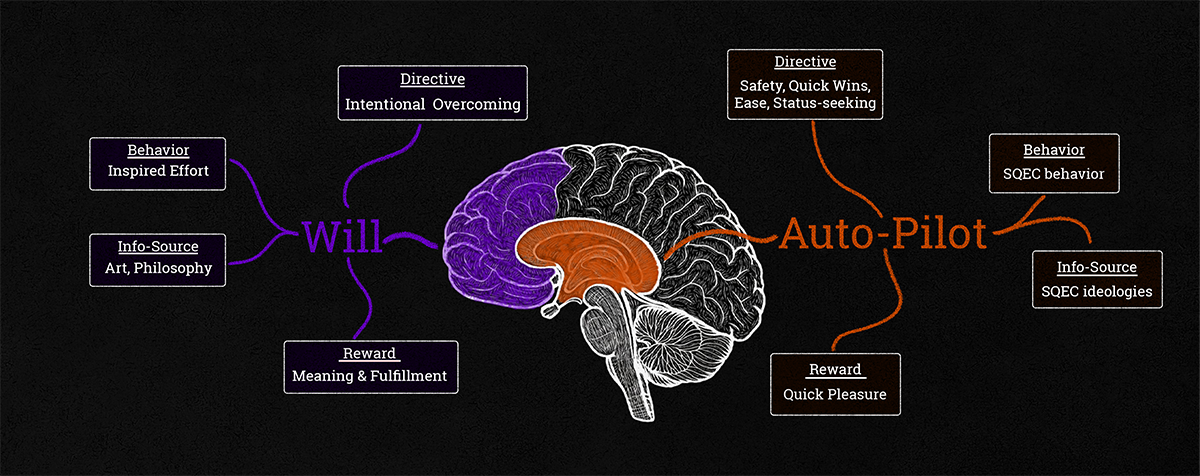
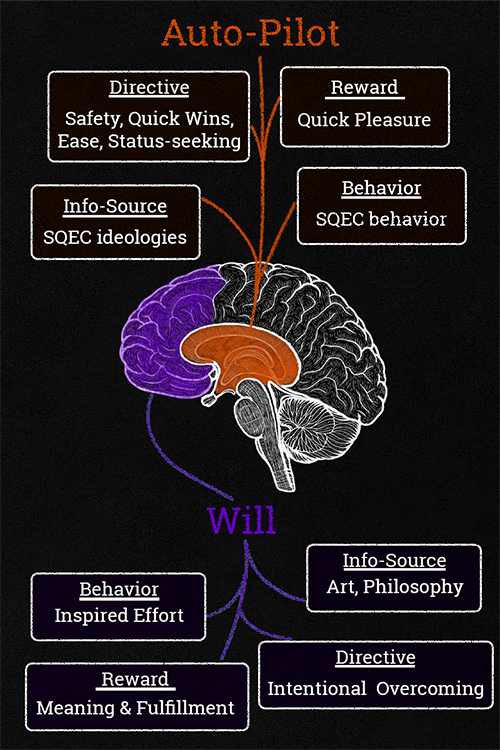
These two forces and their dynamic form the core of the Torn Beings philosophy.
They are always in conflict – by their very nature. If you have ever felt the craving for a donut and the desire for a trim waistline (at the same time nonetheless)… you have felt the struggle between the Will and the Auto-Pilot.
Both the Will and Auto-Pilot are defined by these criteria:

Directives
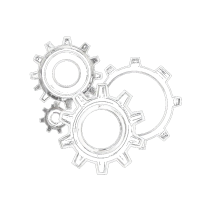
Behaviors
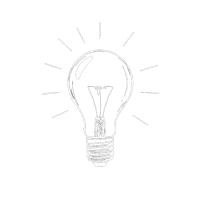
Info-Sources

Reward Systems
Auto-Pilot: Cruise Control
Our Auto-Pilot is our default mode. It’s the reactive consumer craving ease, comfort, safety and instant gratification. The Auto-Pilot sees a red berry and moves to eat it.
It’s also where our habits are situated: those patterns of decisions and actions you don’t think about but “just do”.
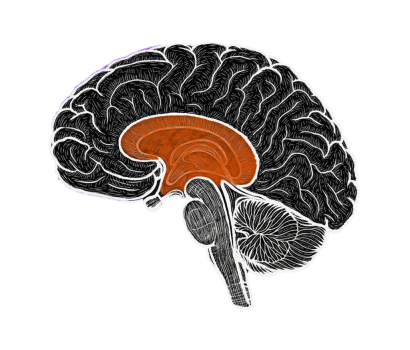
Base Instincts
Our Auto-Pilot runs on a few base directives that shape what actions is suggests and what beliefs it deems acceptable.
Energy Conservation
This is our natural tendency to preserve energy and avoid activities that take a lot of effort. It was installed into us because we used to live in energy scarce environments. Food and water weren’t as readily available as they are now.
Just imagine a caveman doing 3 x 15 deadlifts with a heavy rock. It would be senseless and dangerous, because there was no guarantee of a meal afterwards. Effort brought a real risk of starvation and early check-out.
So, our Auto-Pilot learned to avoid effort.
Risk Avoidance
Imagine the following scenario. You are a caveman (maybe you don’t even have to imagine!). You are searching for berries to eat. Suddenly you hear a rustle in the bushes. Now you have four options.
- You run. There IS a sabertooth tiger. But you avoided getting eaten. Perfect.
- You run. There is NO sabertooth tiger. You may have missed out on some sweet berries. But, you are still alive.
- You investigate. There is NO sabertooth tiger. Alright, turns out there is some fruit here. You actually gained something.
- You investigate. There IS a sabertooth tiger. Now you are cat food.
Of these scenarios, number four is considered absolutely unacceptable by our Auto-Pilot. Being eaten by a big cat is something it wants to avoid.
But most interestingly, this also makes option 3 uninteresting for our Auto-Pilot. The calculation works a bit like this:
- High risk: “There might be a sabertooth tiger.” PLUS
- Uncertain reward: “I am not sure if there are any berries.” PLUS
- Difficult escape: “I can’t outrun a big cat.”
The outcome is “let’s not do that”.
It may very well be the Truth that there is no sabertooth tiger in the bushes, but the Utility of trying to find out is simply too low. A few berries are not worth the risk of becoming a meal yourself. Run!
So, our Auto-Pilot chooses the path with the perceived smallest downside, instead of the path with the perceived highest upside. It wants to avoid risk.
Quick Wins
This is the instinct that makes us crave direct rewards. Let’s go back to that caveman example. He lived in a time where the future was highly uncertain. Imagine he and his buddies killed a big moose. There’s roughly two options:
- Eat everything tonight. There would be no food for tomorrow, but at least nothing goes to waste
- Store some for later. But then what if a rival tribe attacks? What if that sabertooth tiger shows up again?
In an uncertain world, full of dangers, option 1 was the best. Waiting for delayed gratification carried too much risk: the caveman might not have been around to enjoy the delayed rewards!
So, our Auto-Pilot learned to choose the certain immediate reward.
Social Conformity
There is safety in numbers. Ten of us with sharp sticks versus one big cat with long teeth = we win.
We are group animals by nature – we need each other. When working together we can do a lot more than by our lonesome. Challenging dominant beliefs in your group, even if you know the Truth, is risky. If you get kicked out of the group you are left to find berries all by yourself. “What is that rustle I hear in the bushes?”
So, our Auto-Pilot learned to follow the herd.
Consumptive Pleasure
Our Auto-Pilot is consumptive. It wants us to eat a large meal and find a safe bed to sleep in afterwards. Things like that. And it always wants more. More, more, more. It is never completely satisfied.
And our Auto-Pilot has a way to make us follow it: That quick hit when we eat a delicious donut, when we press the button on the slot machine or when we buy a luxury designer bag.
When we consume, our Auto-Pilot rewards us with pleasure.
Conversely, your Auto-Pilot likes to steer you away from anything that takes effort, risk and a bit of patience. Lifting weights or investing your money… All things your Auto-Pilot tries to avoid. When you do these things your Auto-Pilot will nag you. “My muscles burn, I don’t like that.” or “I deserve to buy this luxury bag!”
A Grand Canyon of Habits
The Auto Pilot is by nature habitual. Habits are the action we “just do” repeatedly without thinking about them. A chain of habits may be something like:
Snooze the alarm.
Turn it off after the 5th time.
Rush out of bed.
Brush your teeth (I assume).
Shower.
Put on some clothing.
Head out the door to work.
And all of these steps… while still groggy from sleeping. All of them without paying attention nor thinking. All on the Auto-Pilot.
The Auto-Pilot has this tendency, because habits don’t have large “start up costs”. ‘Thinking’ and ‘deciding’ are actions that cost a lot of energy. Seriously, our brain uses up a massive amount of energy. And coming up with new ways of engaging with the world also adds an element of the unknown – it’s risky.
So, the Auto-Pilot developed a mechanism to deal with that: automation of decisions. Also known as habits. This is our Auto-Pilot’s Energy Conservation and Risk Avoidance at work.
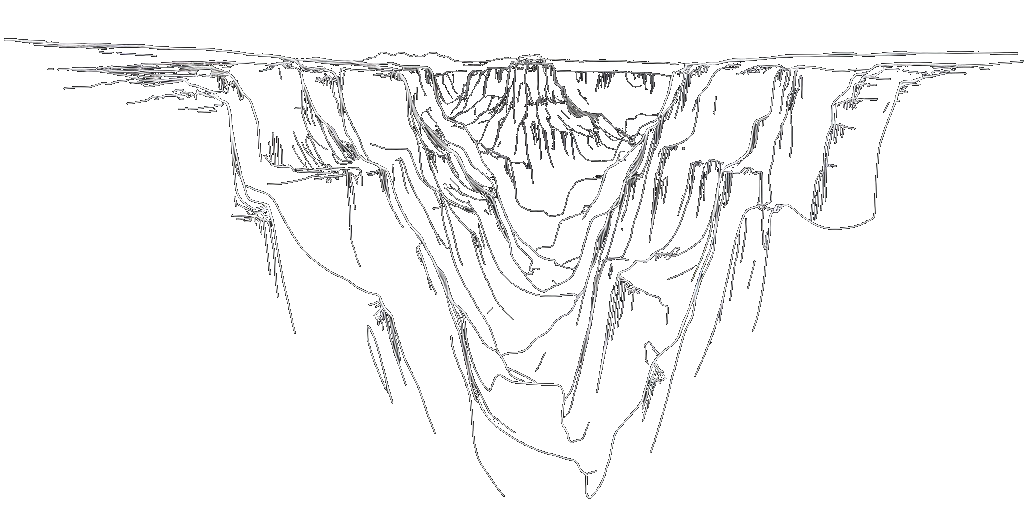
Habit formation is similar to how a stream of water carves out a path for itself. The first drop just follows the pull of gravity through the path of least resistance. It just goes where it finds the smallest obstacles. Perhaps a small carving in a rock that was already there.
But then on its path, the drop carves out a miniscule trail. It takes a little bit of rock with it. This makes the original carving in the rock even deeper – it lowers the resistance of the path even further.
And thus the next drop becomes more likely to follow the same path. And the next one even more so. This keeps going until we eventually form a Grand Canyon of habits.
So, every time you make a decision, you become more likely to make that same decision in similar circumstances. Every time you choose the french fries over the salad in your favorite restaurant, you become more likely to do it again during your next dining session.
SQEC Mental Traps
The existence of our Auto-Pilot explains why we are vulnerable to Mental Traps. Just to recap: Mental Traps are (collections of) ideas that limit our long term flourishing but are hard to escape.
Ideas always come in ‘packages’ – words, paintings, songs, hand signs, funny pictures of cats etcetera. Your Auto-Pilot’s willingness to accept ideas depends on how much their packages make it seem that the ideas fit into the Instinct.exe’s.
So, an idea’s acceptability depends on whether that idea is:
Safe
Is it safe to accept this idea? Does believing this idea create any risks? (Risk Avoidance)
Quick
Can I quickly understand the idea? And does it lead to quick rewards? (Quick Wins)
Easy
How easy is the idea to understand? How easy is the idea to follow? (Energy Conservation)
Cool
Does the idea have a flair of status to it? Does it make me feel better than others? (Social Conformity)
The Auto-Pilot is also reactive in nature. It can’t ‘think deeply’ about the potential long term consequences of an idea. Better yet: It doesn’t even want to! Critical thinking costs a lot of energy. It goes against the Auto-Pilot’s fundamental directives.
The Auto-Pilot does not want to unpack ideas. It just wants them ready to go.
Now not every idea has to perfectly fit all of these criteria. They are not a hard binary on/off switch. Instead, they are like gradual sliders. The higher an idea scores on any of these criteria, the more your Auto-Pilot will want to accept it. So for example, even if the safety of some idea may be ambiguous, the ‘cool’ factor may still make it very attractive for our Auto-Pilot.
Let’s look at an example. We’ll use this idea:
“Investing money is useless. The economy is rigged.”
How does it hold up?
Safe
We all know the examples of investors blowing up their portfolio overnight (yours truly can unfortunately speak from experience). Conclusion for the Auto-Pilot: investing is dangerous, it’s safer to not do it.
Quick
This is the main criterion for this specific idea. Believing that “investing money is useless” gives us the perfect excuse to indulge in impulsive spending.
Easy
The idea is very easy to understand and follow. Very straightforward.
Cool
The sentence ‘the economic system is rigged’ is one of those perfect sentences someone can use to make themselves feel like an ‘intellectual’. Perfect to use during a Christmas dinner to signal intellectual superiority over family members.
Conclusion
“Investing money is useless. The economy is rigged” seems to fit the SQEC criteria quite well, with most points going to the Quick criterion. It may be very acceptable for our Auto-Pilot!
Toxic Ideologies
Ideologies are the perfect tool for our Auto-Pilot. They are pre-made collections of ideas that guide our decisions and actions. Some modern day examples include the Black Pill and Doomerism.
Ideologies often come beautifully packaged. They have their own pictures, stories and exemplar individuals to follow. An Ideology will tell you what is true, how to treat others and how to win at life. And usually, they have some real Truths in them as well.
They take minimal effort to understand and accept. Basically plug and play answers to the question: “What should I do with my life?”.
And that makes them extremely attractive to the Auto-Pilot. Ideologies take away the effort of coming up with your own winning conditions for life. An Ideology is a consumable answer to life’s greatest questions. What could be more Auto-Pilot than that?
But as we follow an ideology, we inevitably come face to face with its toxic elements. But at that point the Auto-Pilot is already so invested in the Ideology that it won’t want to change course anymore. Changing course brings effort and risk with it.
Will: Intentional Overcoming
Our Will is our ability to overcome ourselves and our environment. It enables to be inspired and engage in long term effortful production – and to feel meaning as we do so.
The Will sees the same red berry as the Auto-Pilot, acknowledges the cravings but decides to plant it in order to grow a berry tree.

Deliberate Overrides
Our Will has an essential function: to override our default behaviors – the Auto-Pilot. That’s because the Instinct.exes do not always optimize for our brain’s purpose. In a somewhat stable environment, they may actually lead to a disadvantage, survival wise.
If it becomes somewhat certain that we will be alive tomorrow, then it suddenly also becomes useful to save a bit of food. So, then we need something to stop ourselves from gorging down every piece of food in sight.
In other words: our Will is our ability to 1) develop long term aspirations and to 2) override the Auto-Pilot to strive towards them.
A bit more on the word override. This word implies a certain level of internal conflict. And it’s fitting because the Will has to overcome the Auto-Pilot. It’s the whole reason it exists.
So, the Will naturally has an urge towards overcoming. It has a fighting spirit by definition!
Inspired Effort
Our Will is inherently productive and creative – even if it costs us energy (especially so!). It wants us to build a nice shelter and to put in the work of keeping it clean. It wants us to create.
So, the Will checks for inspired effort.
This is a two part formula – and both parts are absolutely essential. They are like oxygen and fuel to a flame.
Inspired
Inspiration is the oxygen for the Will.
There are many words in the English language that point to a feeling of “I want this”: motivation/ aspiration / ambition etcetera.
Inspiration fits in this family, but also stands out. I define it as a strong drive towards productive and creative overcoming. It’s the feeling that allows us to push through challenges.
It can be something as simple as watching a movie, seeing the hero in action and thinking “Wow, I want to be like that”.
It’s highly abstract and can take many different shapes, but it always acts like a guiding star that helps us direct our effort.
Effort
Effort is the intentional engagement with discomfort. It’s when we willingly expend a lot of energy or go into the scary unknown. And it’s the fuel of our Will.
Our Will checks whether we are not just going through the motions at the gym, whether we are not half-assing the creation of our new website and whether we really did our best when helping someone.
Because without effort, our Auto-Pilot has won. If we do not really put in effort, we are just cruising on our Auto-Pilot by definition.
A Meaning Generator
If you engage in inspired effort the Will generates something that goes deeper and further than the quick rushes of our Auto-Pilot. You get that feeling of presence and intense focus. That feeling of “This is what I am supposed to do” while you’re at it. And a “I am glad I did that” afterwards.
When we feed our Will with inspired effort it generates meaning.
And I emphasize the word “generate” here. A generator takes a fuel, runs it through its machinery and puts out electricity. It takes something from outside, processes it and puts out something new.
This is how I understand the relationship between the external world and the meaning we can undeniably experience. We don’t just ‘get’ meaning from outside, nor do we just ‘create’ meaning ourselves out of nothing. We generate it by taking external things and processing them internally.
Curious Unpacking
The Will offers us long term predictive power, giving us a massive advantage over other species. Instead of reacting to the world like the Auto-Pilot, the Will likes to be multiple steps ahead. So, the Will prefers ideas that have long term utility. It can even produce new ideas by itself.
To that end the Will has to be curious. The Will doesn’t just accept a package of ideas based on how easy, safe, cool and quick the wrapping makes the ideas seem.
No, it puts the effort into unpacking. It questions assumptions and thinks of long term consequences. It actively engages with the information and ideas. It is antithetical to the modus operandi of the Auto-Pilot.
The Will overcomes Mental Traps through curiosity.
Inspiring Art
Where ideologies are the ultimate tool of the Auto-Pilot, art is the ultimate playground of the Will.
I define art broadly: any form of observable expression that can inspire and allows for active engagement.
So it may include a book, a movie, a dance, a poem, a painting. But also things that are often considered “lower order entertainment” like a video game, a comic or a simple online meme. If it creates that spark in you, it’s art.
Again, the definition includes two elements. We have already discussed inspiration, so we just have to unpack the “active engagement” part. Actively engaging with a piece of information requires us to exercise our curiosity a bit. “What does this make me feel?”. “What can I learn from this?”. It’s that process of ‘unpacking’.
The same piece of information can be both an Auto-Piloted ideology or a Willful artwork, depending on whether we actively engage with it. If we treat a set of ideas as an unquestionable dogma that we should follow no matter what – it becomes an ideology. But, if we actively unpack the ideas, seek inspiration and consider how to apply it to our own life – it becomes art.
A Black Hole And A Sun
Both the Will and Auto-Pilot grow as we exercise them. And both can ‘develop’ and ‘embrace’ different philosophies to keep us on their desired track.
The Auto-Pilot starts off as a small void that calls to be filled. The appetite for a sugary drink, the lust for a .xxx website or the rush when buying coins in a freemium mobile game to skip the hard work of levelling up.
But as we pour in more and more decisions and actions, the void only deepens and expands. Follow your Auto-Pilot long enough and you will create a super massive black hole – consuming you.
Its philosophical output: Nihilism. Indulge your Auto-Pilot enough and it gives you a comprehensive list of reasons to give up on life.
The Will starts off like a small spark. An inspiring movie character, a loved one needing guidance, an invention you want to realize or a book you want to write. As you fuel the spark with enough inspired effort and engagement it will grow into a sun – it will lighten up your life.
The output is a philosophy of meaning that is unique to you. Exercise your Will long enough and it gives you a reason to engage with life.
But be wary: this sun and black hole occupy the same universe. As one grows, the other must shrink. And as one grows, its growth speeds up. It’s a cyclical effect – a snowball rolling downhill.
Neither of them ever truly disappears. They are eternal parts of your universe. But they may reach a critical point. Exercise your Auto-Pilot enough and it leaves your Will as a tiny blip of light, only showing itself every now and then. One that requires a deep courageous search to find.
Courageous, because you will surely have to face the void as you try to find that shrinking beacon. Spend enough time sitting on your ass and you won’t want to hear the reasons why you should get up!
But exercise your Will enough and it will put out sufficient light to even fill your Auto-Pilots vortex. Do enough hard reps in the gym and the burn will become pleasant!